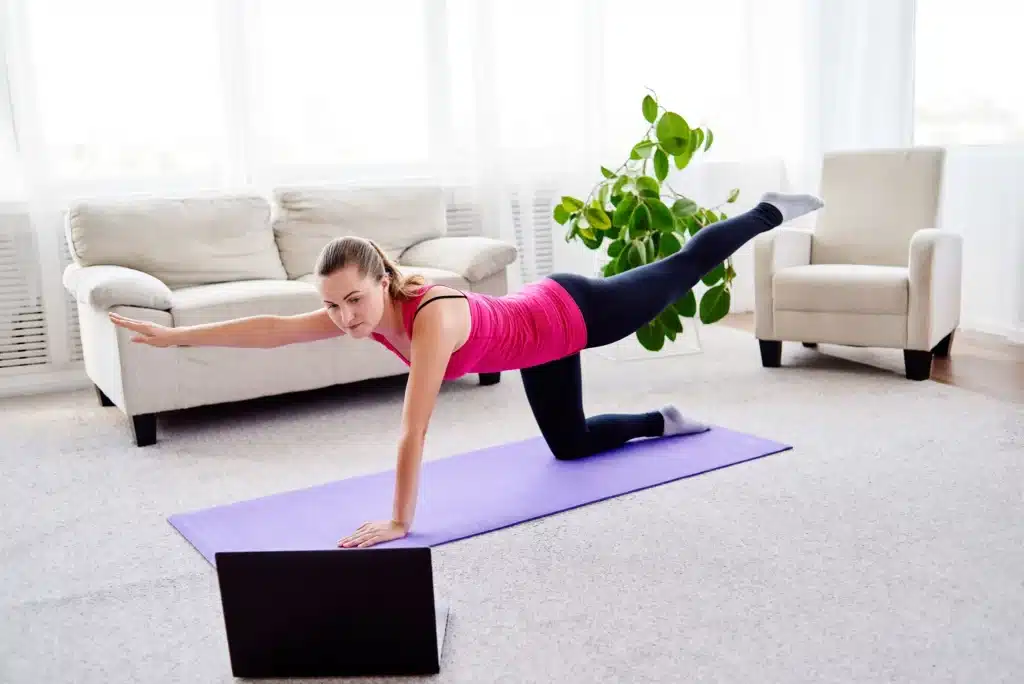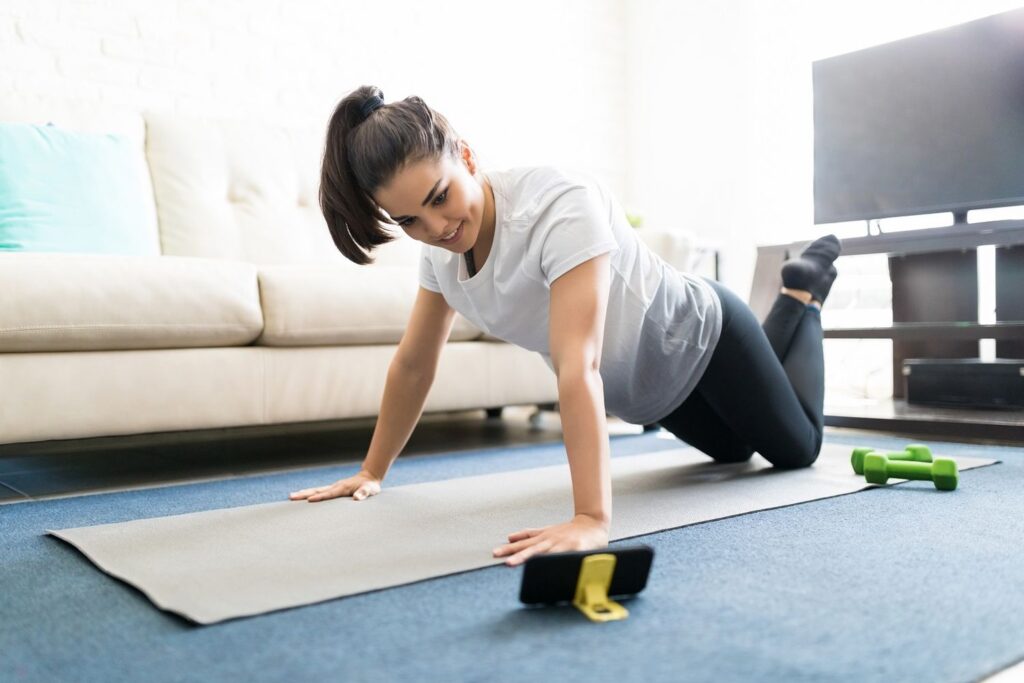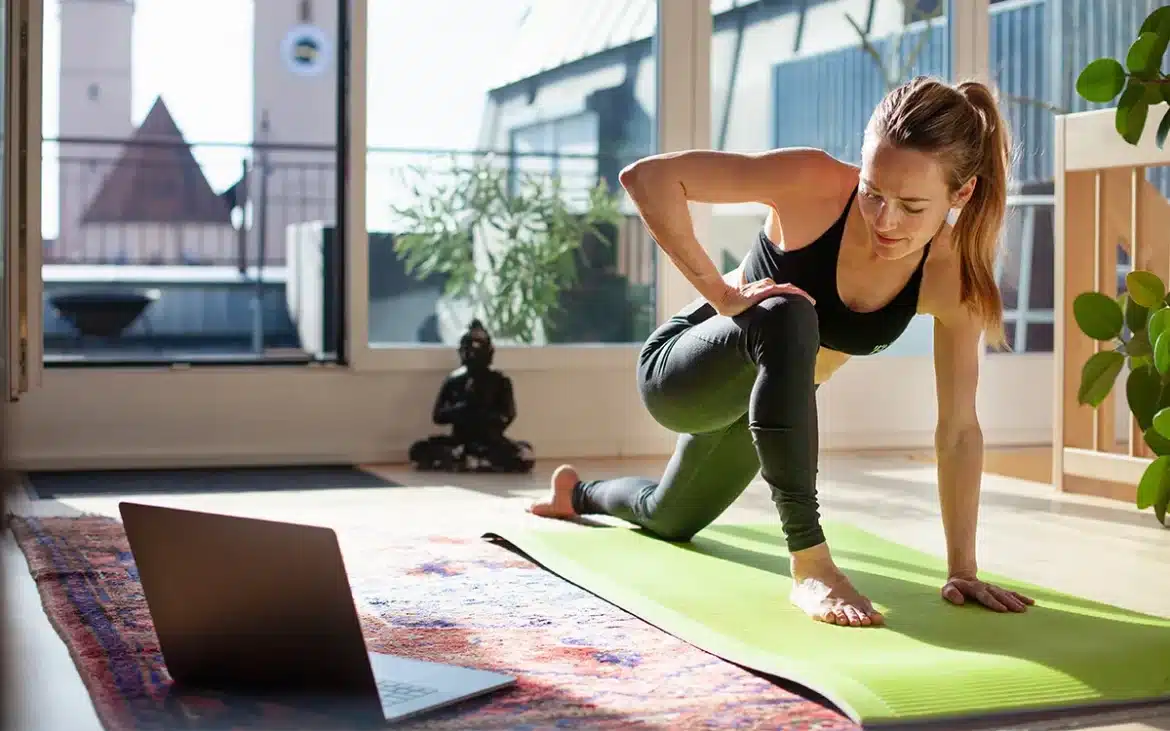Introduction
Does At Home Pilates Work: Pilates, developed by Joseph Pilates in the early 20th century, is a mind-body exercise system designed to enhance physical strength, flexibility, and posture. Traditionally, Pilates was practiced in studios, by trained instructors using specialized equipment. However, with the advent of technology and the ever-growing demand for home-based fitness solutions, at-home Pilates has become increasingly accessible.
This exploration into the effectiveness of home Pilates is vital as it seeks to address the concerns and skepticism surrounding its potential benefits. Can individuals achieve the same transformative results in their living rooms as they can in a professional studio. The answers to these questions have far-reaching implications for those looking to embark on their fitness journey or adapt to the changing landscape of workout routines.
To dissect the efficacy of at-home Pilates, we will delve into several key aspects. Firstly, we will examine the fundamental principles of Pilates and how they translate to a home environment. Understanding the core tenets of this exercise system is essential to evaluating its potential effectiveness. Next, we will explore the accessibility and affordability of at-home Pilates, addressing the equipment, space, and resources required to make it work.

Is Pilates at home effective?
At-home Pilates workouts, using nothing more than a mat and the weight of your body, can be just as effective as using expensive equipment in a studio. With a comfortable surface and your body, at-home Pilates can improve balance, strength, and flexibility.
Core Strength: Pilates is renowned for its ability to strengthen the core muscles, which can improve posture and reduce the risk of back pain.
Flexibility: Regular Pilates practice enhances flexibility by focusing on stretching and lengthening muscles, leading to increased range of motion.
Balance and Coordination: Pilates exercises often involve precise movements that challenge your balance and coordination, contributing to better overall body control.
Muscle Toning: Pilates targets various muscle groups, helping you achieve lean and toned muscles without excessive bulk.
Stress Reduction: The mindful and controlled movements in Pilates can promote relaxation and reduce stress levels.
Can you lose weight with at home Pilates?
Pilates can help you burn a good number of calories, but it may not be a good option for you if you are looking to lose weight fast. It is not as efficient as conventional cardiovascular exercises such as rope jumping, cycling, and jogging. Nonetheless, it can form an integral component of any weight loss plan.
Caloric Expenditure: At-home Pilates workouts can burn calories, particularly if the routines are challenging and continuous. However, the calorie burn is generally lower compared to high-intensity cardio exercises like running or cycling.
Muscle Building: Pilates helps build lean muscle, which can increase your resting metabolic rate. This means you’ll burn more calories even when you’re not exercising.
Improved Posture and Body Awareness: Better posture through Pilates can make you appear taller and leaner. Additionally, the heightened awareness of your body may lead to healthier eating habits and portion control.
Stress Reduction: Pilates promotes relaxation, which can reduce stress-related eating and emotional eating.
Consistency Matters: To see significant weight loss results with at-home Pilates, it’s essential to be consistent with your practice. Aim for at least 3-5 sessions per week, and gradually increase the intensity and duration of your workouts.
How long does it take to see results from at home Pilates?
about 3 weeks
While individual experiences will vary, many people begin to notice physical improvements within a few weeks of consistent Pilates practice (usually the initial results within about 3 weeks) This is because even in the first few weeks, your ability to activate the correct muscles and be aware of your posture begins to.
Improved Posture: Many people notice improvements in their posture within a few weeks of consistent Pilates practice. Strengthening the core muscles can help support the spine, leading to better alignment and posture.
Increased Flexibility: Enhanced flexibility may also become apparent in the first few weeks, especially if you focus on stretching exercises within your Pilates routine.
Core Strength: Building core strength can take a bit longer, typically around 4-8 weeks of regular practice. You’ll likely start feeling more stable and strong in your core during everyday activities.
Body Toning: Visible body toning and muscle definition often become noticeable after 2-3 months of dedicated Pilates workouts. This can vary depending on the intensity of your sessions and your starting point.
Weight Loss: If weight loss is your primary goal, it may take longer to see significant changes through Pilates alone. Combining Pilates with a healthy diet and cardiovascular exercise can expedite the weight loss process. Visible weight loss may take several months.
Why am I not seeing results from Pilates?
One of the main reasons you may not be feeling or seeing the results of your Pilates workouts is your consistency, or lack thereof. While you may be getting some benefits from yo-yoing from 5 classes one week, to a two week break, you’ll find far greater results from building a solid foundation from the get go.
Inconsistency in Practice: One of the most common reasons people do not see results from Pilates is irregular practice. To experience the benefits of Pilates, it’s crucial to maintain a consistent workout schedule. Aim for at least 3-5 sessions per week to build strength and flexibility gradually.
Lack of Intensity: Pilates can be tailored to different fitness levels, and the intensity of your workouts matters. If your routine is too easy or does not challenge you enough, it may not yield the desired results. Consider progressively increasing the intensity and complexity of your exercises as your strength improves.
Improper Form: Pilates is all about precise movements and body control. If your form is incorrect, you may not engage the targeted muscles effectively. Investing in professional instruction or using online resources to ensure proper form is crucial for success.
Unrealistic Expectations: Sometimes, people expect quick and dramatic changes from their Pilates practice. While Pilates offers numerous benefits, it may take time to see visible results, especially if you’re working toward specific goals like weight loss or muscle definition. Patience is key.
Limited Variation: Repeating the same Pilates routine without incorporating new exercises can lead to plateaus in your progress. Variety is essential to challenge your body and prevent stagnation. Explore different Pilates workouts and incorporate a diverse range of exercises.
Is 30 minutes of Pilates a day enough to lose weight?
A 155-pound person burns approximately 260 calories in 30 minutes of doing beginner-level Pilates, according to the American Council on Exercise. Pilates can help you build muscle. Muscle tissue burns more calories than fat tissue, so building muscle with Pilates can help you burn more calories and lose weight.
Caloric Expenditure: Pilates can help you burn calories, although it’s generally not as calorie-intensive as high-intensity cardio workouts like running or cycling. The number of calories burned during 30 minutes of Pilates depends on factors like your weight, intensity, and the specific exercises you perform.
Muscle Building: Pilates engages multiple muscle groups, which can increase your resting metabolic rate. Muscle burns more calories at rest than fat, so building lean muscle through Pilates can support weight loss over time.
Consistency: Consistent daily practice is key to seeing results. Regular Pilates sessions can help you maintain a steady calorie burn and build muscle over time.
Diet and Nutrition: Weight loss is significantly influenced by your diet. Combining a healthy, balanced diet with your Pilates routine will yield better results. Be mindful of your calorie intake and focus on nutrient-dense foods.
Individual Factors: Weight loss results can vary widely from person to person due to factors like genetics, age, metabolism, and starting weight. Some individuals may see more rapid changes than others.
How many times a month should I do Pilates to see results?
When creating your ideal Pilates workout schedule, devise one that works with your lifestyle and helps you meet your specific fitness goals. While three or four workouts per week may be ideal, two or even once-weekly sessions can still offer health benefits.
Fitness Goals: The frequency of your Pilates sessions should align with your specific fitness objectives. Are you looking to enhance core strength, improve flexibility, build muscle, or achieve weight loss? Different goals may require different frequencies.
Experience Level: Your experience and familiarity with Pilates can influence how often you should practice. Beginners may benefit from more frequent sessions to build a solid foundation, while experienced individuals may maintain their progress with fewer sessions.
Intensity of Workouts: The intensity of your Pilates sessions matters. Higher-intensity workouts may necessitate more recovery time between sessions, while lower-intensity routines may be done more frequently.
Lifestyle and Schedule: Your daily routine, work commitments, and other obligations play a role in how often you can realistically do Pilates. Find a schedule that fits your lifestyle.
Recovery and Rest: Adequate rest and recovery time are crucial to prevent overtraining and reduce the risk of injury. Pilates, like any exercise, places stress on your body, and it’s essential to allow for sufficient recovery.
How often should you do Pilates to get in shape?
The optimal range of Pilates classes is 3-4 times a week. Beginners can aim for 2 times. Still, you should see results even by practicing Pilates once a week. Combining it with cardio or high-intensity training can help you lose weight and alter your body shape.
General Fitness: If your primary goal is to improve your overall fitness, 3-4 Pilates sessions per week can be a good starting point. This frequency allows for consistent progress in strength, flexibility, and endurance.
Core Strength: To enhance core strength and posture, 2-4 sessions per week may be sufficient. Pilates is renowned for its ability to strengthen the core muscles effectively.
Flexibility: If flexibility is a priority, consider incorporating Pilates into your routine 3-5 times a week, combining it with stretching exercises to maximize your gains.
Muscle Building: To build muscle and tone your body, 3-4 Pilates sessions per week, complemented by strength training exercises, can be an effective strategy.
Weight Loss: If your goal is weight loss, you may need more frequent Pilates sessions, typically 4-6 times a week, in combination with cardiovascular workouts and a calorie-conscious diet.
Why is Pilates not changing my body?
Pilates does not change your silhouette; rather, it helps us build a leaner and more sculpted body, eschewing muscle building in one area in favor of an all-over methodology. Before starting our Pilates journey, we might notice that our muscles are not very toned and that we carry some unnecessary body fat.
Inconsistent Practice: One of the most common reasons people do not see changes in their body through Pilates is inconsistency. Pilates, like any exercise program, requires a consistent routine to produce results. Skipping sessions or practicing irregularly can impede progress.
Insufficient Intensity: The effectiveness of Pilates can vary depending on the intensity of your workouts. If your Pilates routine lacks challenge and intensity, you may not experience significant changes in your body. To continually progress and challenge yourself with more advanced exercises.
Inadequate Duration: Pilates sessions typically last 30-60 minutes. If your sessions are too short or lack variety, you may not engage all muscle groups effectively. Consider extending your sessions or incorporating different Pilates exercises to ensure a comprehensive workout.
Nutrition and Diet: Pilates alone may not lead to dramatic changes in your body if your diet is not supportive of your fitness goals. A balanced diet that aligns with your objectives is crucial for achieving desired physical changes.
Misaligned Goals: Sometimes, individuals may have unrealistic expectations about what Pilates can achieve. Pilates is excellent for improving strength, flexibility, and posture, but it may not necessarily result in dramatic weight loss or muscle bulking.

Conclusion
One of the strengths of at-home Pilates lies in its adaptability to various lifestyles. It eliminates the need for daily commutes to a studio, allowing individuals to seamlessly integrate workouts into their schedules. Moreover, it caters to a broad audience, from beginners to experienced practitioners, offering a range of exercises that can be customized to suit individual needs and fitness goals.
The growth of online platforms and virtual instruction has also significantly enhanced the accessibility of at-home Pilates. Through video tutorials and live-streamed classes, individuals can receive guidance and support akin to that offered in a studio setting. This technology bridges the gap between in-person instruction and at-home practice, ensuring that individuals can maintain proper form and technique. At-home Pilates is often more cost-effective than studio-based alternatives, as it eliminates the need for expensive memberships and equipment. Basic Pilates exercises can be performed with minimal equipment, such as a mat and resistance bands, making it a budget-friendly option for those with limited resources.
The success stories and testimonials of individuals who have experienced transformative results through at-home Pilates underscore its effectiveness. Many have reported improved core strength, posture, and overall fitness, showcasing the potential for significant physical and mental benefits.

